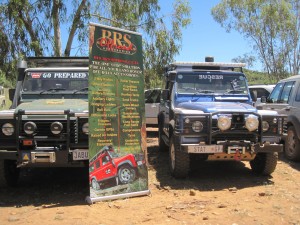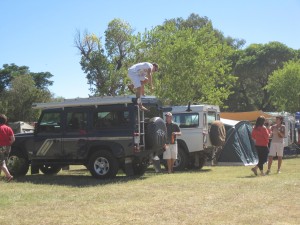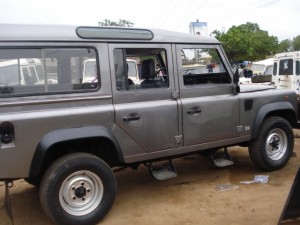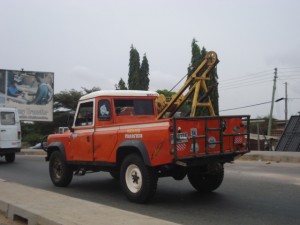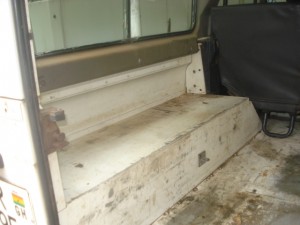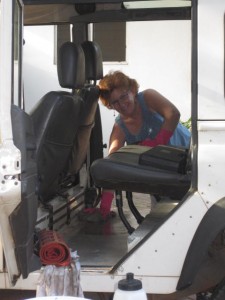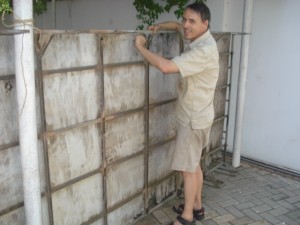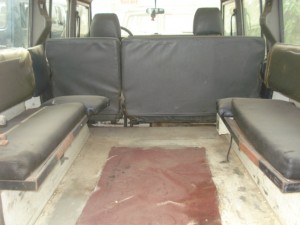Who ever heard of such a thing as a Land Rover Festival? But there it was, featured on the sheet on the counters or walls of the various overland outfitting shops we visited in the first couple of days in our recent trip to Johannesburg in South Africa. Apparently, part of the idea of the festival was to try to break the Guinness World Record for the greatest number of Land Rovers in a single convoy. An added incentive for us to attend there were a large number of suppliers offering on-site sales, including a “boot sale” which is the British/South African/I’m not sure where else equivalent of a flea market.
As shopping for items for the outfitting stage of our own Land Rover project was the main reason for our trip to South Africa, the opportunity to hang out with other Land Rover owners in what is arguably the world centre for Land Rover overlanding is not something easily passed up. Despite the attraction, the fact the so-called festival was taking place during the time we had booked for a 3 day trip to Victoria Falls between Zambia and Zimbabwe, one of Africa’s premiere destinations presented no small dilemma. Victoria Falls is a place that I have wanted to get to for a long time and we had decided to priorize our time for Vic Falls in what may be our last trip to South Africa before our Ghana posting ends this summer. The solution we chose to resolve the dilemma was to split the difference. Delay the trip to Victoria Falls by one day to catch the first day of the two day Landy festival (missing the Guinness record shot convoy) but still be able to spend two nights at beautiful Victoria Falls.

The timing actually worked out very well. Laura decided to hold to the original schedule and go to Victoria Falls on Saturday morning and I was able to reschedule my flight by one day and take Laura to the airport in Jo’burg in our rented Volvo at 8:00 AM on my way out to Vaal, the rural district south of Jo-burg where the festival was scheduled to take place. It is worth mentioning the Volvo because it was, without any doubt, the only one present at the Land Rover Festival.
As usual, getting there was half the fun. I had obtained directions on-line how to get to the Malojeni Guest Farm, which was the site of the festival, from the Oliver Tambo Airport in Jo’burg. Unfortunately I learned too late that for some reason my Blackberry could not download the full directions file so I had instructions about two thirds of the way. I ended up in the middle of a very pleasant Vaal town called Meyerton. After unsuccessfully trying to get directions from a service station I was able to close the distance simply by following a Land Rover I saw driving by. It was while en route at this point that the Woodstock analogy first occurred to me. The line “going down to Yasgur’s farm” from the CSN song popped into my head at a small country junction where three Landys coming from three different directions converged and all headed up the same road. Clearly, I was headed in the right direction.
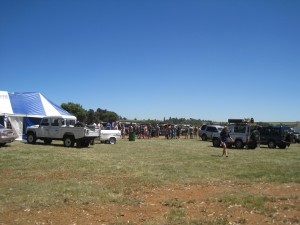
The South African love of Land Rovers is such a phenomenon because of a couple of factors. The South African Armed Forces was/is a big user of Landy’s, and thus a source of slightly used “surplus” product for the population at large over a number of years. Another factor in all of this is the South Africans’, specifically the Afrikaaners’, love of overlanding. This is one of the features of Afrikaan’s culture that we have really come to appreciate through our visits here and the knowledge of history that comes with that. One of the defining moments of the Afrikaaner’s history was the “voortrek”, the overland journey taken by the Dutch settlers in the 1840’s to get away from the Brits that were encroaching in the more accessible areas around Cape Town where the Dutch had first settled a couple of generations earlier. The Afrikaaners are a fiercely independent people and extremely proud of their heritage. The “voortrek” became an fundamental part of Afrikaaner history and culture and by carrying through on their love of adventure and exploration of remote areas the Afrikaaners played a huge role in defining the African overland experience through pioneering trips into the some of the more remote areas of southern Africa, including Botswana, Mozambique, Namibia, Zimbabwe, Zambia and points beyond. The vehicle of choice for most of this overlanding has been the Land Rover Defender. It is really an incredible cultural phenomenon, one that has led to the proliferation of a huge number of overland outfitters and suppliers in the country, not limited to Land Rovers of course but certainly favouring them.
This title of the festival was “My Land Rover Has a Soul”, (MYLRHAS’ is the acronym). This illustrates the passion that South African Land Rover owners have for their vehicles and that passion was very evident at the festival. There were hundreds and hundreds of vehicles there on Saturday, every model ever made well represented, Series, Defenders, Discoveries and big 130s, all boasting their own particular style and personality. Some were very stock, others very customized and colourful. But it is not really so much the vehicle, the Land Rover has just perchance become a modern day expression of the Afrikaaner`s love of overland travel. Afrikaans was the first language at the MYLRHAS festival, and the festival was really less about the specifics of Land Rover mechanical or body design than it was about overland equipment outfitting: tents, awnings, cooking equipment, storage, water systems etc. all things which the very functional Land Rover design is conducive to. There was even an expedition wine carrier.
Other elements of South African/Afrikaans culture were well represented at the festival. Virtually all the food came off from the “braai”, the ubiquitous SA barbecue. Indeed the air was so thick with charcoal smoke, whether from a couple of communal braais or the many individual ones at the various campsites, that it was sometimes difficult to breath. South Africans are crazy about braais, for boerwurst sausage, or burgers or steak. They are also crazy about beer. Canadians also love their beer, but here virtually everyone was walking about visiting the shops and displays at 11:00 o’clock in the morning with a beer in their hand. This is not a culture I have any difficulty adapting to.

M&M’s product line includes leather “expedition wine cases” for your Pinotage
There were hundreds of vehicles and thousands of people, plenty of families with kids. In addition to the food and expositions there were helicopter rides, and an air show. No flying Land Rovers, rather some old, loud, single engine planes that were unspectacular but steady, like Land Rovers would be if they had wings. I sat down with my boerwoerst and beer lunch to listen to the live singer/guitarist musician whose repertoire included Van Morrison, Simon and Garfunkel, Sting, and, incredibly, Led Zeppelin. All good music for the white, baby-boomer audience in attendance, But after he was done with the boomer stuff the musician switched to Afrikaaner folk songs and the response was enthusiastic, to to say the least. I was treated to a real Afrikann`s culture moment, complete with beer and braai and songs about independence and overland travel. If there were any blacks there I did not see them, this seems to be exclusively a white South African, Afrikaans cultural phenomenon.
In addition to the cultural experience, I was able to benefit from the collection of overland outfitters and suppliers. In addition to a better knowledge of the market I came away with a floor-mounting safe for our vehicle, as well as a lovely Land Rover cap that I have always wanted but never came across.
I did miss the Guiness Record shot. The convoy apparently had 1007 Land Rovers of various vintages and models, ranging from Series from the 50s and 60s to just-off-the-line Discovery 5s and the new euro-styled Range Rover Evoque. The line stretched for 24 kilometres between first and last Landy. Apparently they are waiting to hear from Guiness if they have the record, but I can’t imagine anyone every getting more than 1,000 Land Rovers in a convoy before. There are some videos on youtube…….
I would have loved to have been able to stick around to overnight and to participate in the Sunday convoy, but my rented Volvo would hardly have fit in, so heading back to Jo`burg to catch the Sunday morning flight to Victoria Falls was easy to do.



